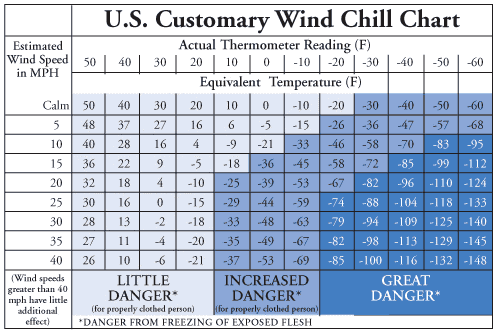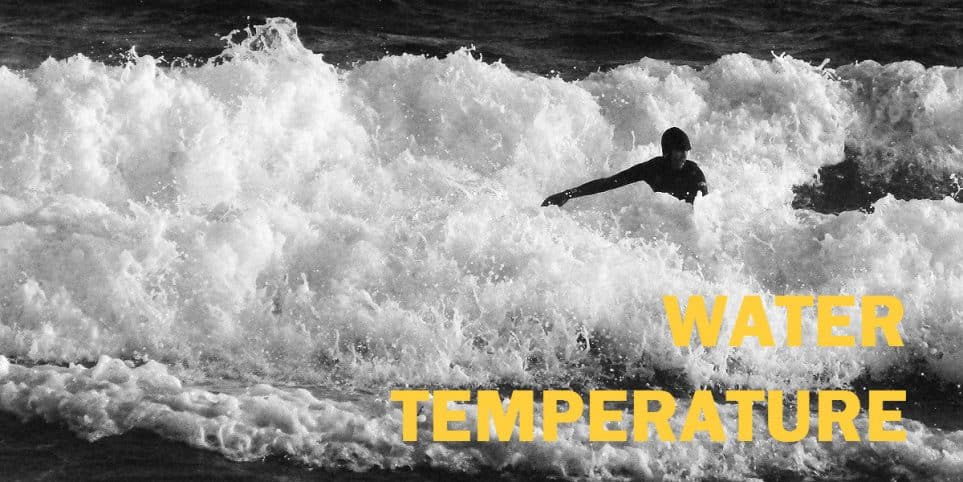NOTE: If you are looking for wetsuit thickness/water temperature chart for scuba diving check this article.
What wetsuit, what thickness of neoprene to choose for certain water temperature? It depends on a couple of factors and water temperature is just one of them. When choosing the right wetsuit for a certain water temperature and conditions, the main factors to consider are water temperature, air temperature, wind, cold sensitivity and activity. Lets take a look at what each of them means (if you just want the thickness/temperature chart skip this and go down):
Water temperature
This one is the main factor and the most obvious one – in colder water you need a thicker wetsuit. Obviously. An interesting fact here is that water pulls heat out of your body about 25 times faster than air! Or to be more precise – it’s conductivity is 25 x conductivity of air (conductivity of a substance is defined as ‘the ability or power to conduct or transmit heat). Basically this means that you wouldn’t last very long in cold water without a wetsuit and would die of hypothermia.
How Long Can a Person Survive in Cold Water (Without a Wetsuits)?
The coldest water you can find will usually be around 39-41-degree F/ 4-5 degree C (remember the water density before it turns to ice lesson from high school?). Generally, a person can survive in water at that temperatures for 10 to 20 minutes. This is how long it would take for the body temperature to drop down to between 70 and 80 degrees F/ 21 – 27 degrees C. This is when cardiac arrest usually occurs. Even before that moment muscles get weak, you lose coordination and strength… But ice cold water is not the only one that is dangerous. Because of the before mentioned conductivity even water temperatures as high as 75 – 80 degrees F / 24 – 27 degrees C can be dangerous. Here is the expected survival time in correlation with water temperature:
Water Temperature And Expected Time of Survival Chart
| Water Temperature | Expected Time Before Exhaustion or Unconsciousness | Expected Time of Survival | |
|---|---|---|---|
| (°F) | (°C) | ||
| 32.5° | 0.3° | < 15 minutes | 45 minutes |
| 32.5–40° | 0.3–4.4° | 15 – 30 minutes | 30 – 90 minutes |
| 40–50° | 3.3–10° | 30 – 60 minutes | 1 – 3 hours |
| 50–60° | 10–15.6° | 1 – 2 hours | 1 – 6 hours |
| 60–70° | 15.6–21.1° | 2 – 7 hours | 2 – 40 hours |
| 70–80° | 21.1–26.7° | 3 – 12 hours | 3 hours – indefinite |
| > 80° | > 26.7° | Indefinite | Indefinite |
Air temperature
Air temperature is a lot of times connected with water temperature. Warmer air & water in summer, colder in winter time. But there are places where ocean currents influence water temperature so much, that it can be way off from what you would expect. So there are times when air and water temperature are “out of sync”. This is usually a problem if you expect warm water in hot weather. If its vice versa and you are surprised by warm water in cold winter you can just do a fist pump :). Anyway – a really hot and sunny day can decrease the feeling of cold despite the cold water.
Wind
Wind cools the surface of your body and increases the feeling of cold. So if you use your wetsuit in wind you need a thicker one. Wind is a serious factor and has quite a big influence on the feeling of cold. Check out this chart to get the feeling what kind of wind chill certain wind strengths bring:

Cold sensitivity
Just how quickly do you get cold? Everyone has a bit different personal aversion to cold. Usually also men are more “immune” to cold than women.
Activity
What are you doing in the water and how active are you? For instance, you can surf so hard smoke comes from your ears or you can sit on your surfboard thinking, meditating and contemplating whatever. You can paddle your raft with all your power or you can calmly float underwater while diving. An active body produces more heat.
The Chart
The wetsuit thickness chart below is not carved in stone. It is for your orientation and is a bit on the safe side, so you can stay in the water longer. Or lets put it this way – it takes into the account that there is some wind present. A few more thoughts:
- Every person knows for himself how sustainable to cold he is and how quickly he gets cold.
- Thicker wetsuit also means you get tired sooner because your movements are more restricted.
- New and snug wetsuit will be warmer that an old, stretched out one of the same thickness.
- Quality of the wetsuit definitely counts (this is why good winter suits for low temperatures aren’t cheap).
Before we get to the temperature chart I can see some hardcore surfers complaining that they can surf in a shorty wetsuit in 59F (15 C) degree water. But why would you want to? I’ve had moments when blood slowly starts coming back to your fingers that are so numb you can’t get out of your wetsuit for half an hour and every heartbeat feels like someone is smashing your fingers with a hammer. When I thought my feet belong to some rubber dummy while I was cobblestone dancing out of the water. It is a part of why I love what I do and a great after dinner story. But I will take a little water behind my neck to cool down instead of this shit every time:).
You probably also found wetsuit/water temperature charts done by major wetsuit companies. Lots of them are in my opinion not very realistic. I guess they also partly use them for marketing purposes. Like: “You only need a 3/2 XY wettie in 54F (12C) water…because this the most technically advanced wetsuit on the planet is so advanced you can sleep in a freezer.” If they are not talking about the battery heated wetsuit, then they are probably full of shit.
WATER TEMPERATURE WETSUIT CHART
WATER TEMPERATURE |
WETSUIT THICKNESS |
WHAT TO WEAR |
|
| > 77 F > 25 C |
You don’t need a wetsuit, unless you usually wear a wetsuit to jacuzzi, sauna, to the beach… | ||
| 72F–77F 22C-25C |
Shorty when it gets colder outside, like in the morning, evening and if it is windy. If the weather is warm, you still don’t need a wetsuit. You can also get away with a good wetsuit top/vest. | ||
| 68F–72F 20C–22C | This is the comfortable bottom limit for surfing in shorty. Spring suit or 3/2 full suit is better for days without sun or if it gets windy. | ||
| 64F–68F 18C–20C |
Spring suit or full suit 3/2. If you only have one wetsuit and it is 4/3 – no worries, you can also use it. | ||
| 59F–64F 15C–18C |
A good 3/2 full suit is OK, but in the lower part of this range 4/3 wetsuit works better and in any weather. | ||
| 54F–59F 12C–15C |
Somewhere in the middle of this range booties become necessary, at least if you like to feel you feet. A 4/3 wetsuit will work. If you will do a lot of surfing in water at the bottom of this temperature range, you should get a 5/3. | ||
| 48F-54F 9C-12C |
5/3 or 5/4/3 wetsuit with booties. If it’s cold and windy also wear a hood and gloves. I hate wearing gloves so they are the last piece I put on. | ||
| < 48 F < 9 C |
5/3 can work, 6/5/4 is better, depends on how extreme do you want to get. Often it is not the thickness of the wetsuit, but bad booties, gloves etc that are the source of cold. So not only the wetsuit, also the booties, gloves and hood must be thick (at least 5mm). |
With good equipment, there is no limit for cold water surfing. With all the possible combinations people often ask which wetsuit thickness should they buy? In my experience: “If you only get one wetsuit – get a 4/3!” It is the most versatile and useful in widest range of temperatures.
Two Cold and Wet Wetsuit ‘Tricks’
Since we finished the chart with some really cold water, here are also two useful tips for putting on a cold wet wetsuit.
- Wet wetsuit is harder to put on than dry, not just because of the great and enjoyable wet and cold feeling but also because it sticks to your skin and it won’t go on. So to do it faster, put a PVC bag on you leg or arm before you push it through your wetsuit. Your arms/legs will slide through the sleeves like a hot knife through butter.
- The other trick is to have a dry rash guard in store. Put it on before you get into a wet wetsuit and you won’t feel the cold neoprene on your body.
The final trick would be to just suck it up and get over it as quickly as possible and then get into the water and catch a few while your buddies are still whining in the parking lot :).
PS: The is one more chart in this article as well.
PPS: If you find this article and char useful please share it on FB/Twitter etc… Many tnx!
